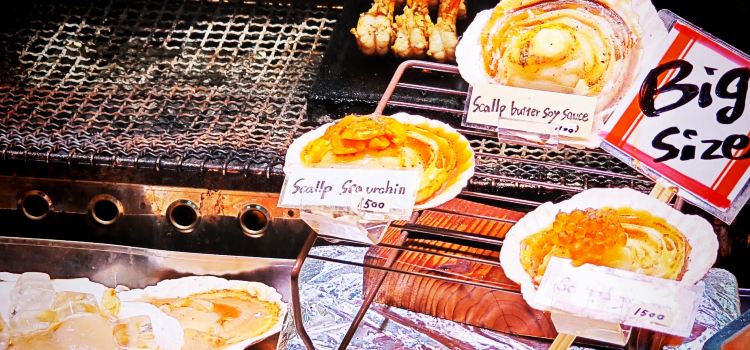味処(とれとれ市場南紀白浜外店)
No comments yet

What travelers say:

Toretore Market (Nanki Shirahama Market), the largest seafood market in western Japan🦞🐠🐡🐟🦑🐙🦐🦀️, is also a check-in spot for Conan fans📷
🗺Address: 2521 Katada, Shirahama-cho, Nishimuro-gun, Wakayama Prefecture
⏰Business hours: 08:30-18:30
🍴Dine-in area: There are many shops offering seafood bowls, sushi, set meals and other delicacies, as well as cafes with special dishes such as panda-themed "Panda Curry" and "Oven-baked Hot Pancake Set", as well as shops offering soft serve ice cream and milkshakes made from fresh milk, etc.
🐟Fresh fish area: Fresh fish directly delivered from Wakayama and all over Japan, as well as live crabs and Ise lobsters from Hokkaido
🍖BB Q area: located next to the market gate (Figure 3⃣️), limited to 105 minutes, admission from 11:00-16:30 on weekdays, admission from 10:00-17:00 on weekends and holidays
🐠Tuna dissection show: In the tuna area, there is a tuna dissection show every day, and freshly cut tuna will be sold on site at a preferential price to those who arrive first Customers
💰Cuttlefish sashimi (Figure 6⃣️), 800 yen💴
💰Scallop sashimi (Figure 7⃣️), 1000 yen💴
💰Sea urchin donburi (Figure 8⃣️), 800 yen💴
💰Seafood sashimi donburi (Figure 1⃣️4⃣️), 1400 yen💴
💰Sashimi boat (Figure 1⃣️7⃣️), 2500 yen💴
#日本深度游旅行攻略 #日本旅行 #日本旅游 #日本旅游攻略 #日本自驾游
More
Reviews of 味処(とれとれ市場南紀白浜外店)
Some reviews may have been translated by Google Translate
0/5
All (3)
Latest
Photo reviews (2)
Toretore Market (Nanki Shirahama Market), the largest seafood market in western Japan🦞🐠🐡🐟🦑🐙🦐🦀️, is also a check-in spot for Conan fans📷 🗺Address: 2521 Katada, Shirahama-cho, Nishimuro-gun, Wakayama Prefecture ⏰Business hours: 08:30-18:30 🍴Dine-in area: There are many shops offering seafood bowls, sushi, set meals and other delicacies, as well as cafes with special dishes such as panda-themed "Panda Curry" and "Oven-baked Hot Pancake Set", as well as shops offering soft serve ice cream and milkshakes made from fresh milk, etc. 🐟Fresh fish area: Fresh fish directly delivered from Wakayama and all over Japan, as well as live crabs and Ise lobsters from Hokkaido 🍖BB Q area: located next to the market gate (Figure 3⃣️), limited to 105 minutes, admission from 11:00-16:30 on weekdays, admission from 10:00-17:00 on weekends and holidays 🐠Tuna dissection show: In the tuna area, there is a tuna dissection show every day, and freshly cut tuna will be sold on site at a preferential price to those who arrive first Customers 💰Cuttlefish sashimi (Figure 6⃣️), 800 yen💴 💰Scallop sashimi (Figure 7⃣️), 1000 yen💴 💰Sea urchin donburi (Figure 8⃣️), 800 yen💴 💰Seafood sashimi donburi (Figure 1⃣️4⃣️), 1400 yen💴 💰Sashimi boat (Figure 1⃣️7⃣️), 2500 yen💴 #日本深度游旅行攻略 #日本旅行 #日本旅游 #日本旅游攻略 #日本自驾游
🍂 Ginkakuji Outpost: The Crispy Yuba Revolution As you step out of Ginkakuji Temple early in the morning, you must try the "Kyoto Specialty Yuba" at the entrance—thinly fried tofu slices wrapped in semi-melted cheese (price increased from 500 to 650 yen per portion). The outer layer is crispy, like the white sand patterns of a dry landscape garden, while the cheese inside flows like moonlight soaking into the silver beach. It's best to tear it open while it's still hot. The scalding milky and bean aromas burst in the cool air. Paired with the morning mist from the moss garden, it creates an eerie harmony between Zen and heat. As the stall owner skillfully collects the cash, be sure to glance behind him for the wooden sign "No Eating While Walking"—a perfect illustration of Kyoto's paradoxes. Ginkaku-ji Temple 🦐 Nishiki Market's Nuclear Zone: A Dual-Form Fried Shrimp Showdown In the afternoon, I headed to Nishiki Market, known as "Kyoto's Kitchen," and targeted two fried shrimp stalls: Direct Fire: Yuli's blowtorched shrimp (due to the recent surge in tourism in Japan, the price has risen to 950 yen per skewer). The shrimp instantly curls up in the 300°C blue flames, the caramelized shell enveloping a runny, liquid shrimp paste, a burst of sea-fresh sweetness that reaches the top of your head. The owner casually chatted on the phone while blasting flames. ✅ Note: The entire Nishiki Market has always targeted foreigners, primarily Western tourists. While there are a lot of Korean and Chinese tourists, they tend to follow food guides or join tour groups. Unlike Kuromon Market, this market is less appealing than smaller cities like JR Shirahama Station, where you'll find more local flavors (Toretore Market Nanki Shirahama Outer Branch). Breadcrumb warriors: Kawakatsuya's tempura shrimp (currently 1,000 yen per portion) boasts a light, thin batter reminiscent of the gilding of Kinkakuji Temple. The crunching sound is like the raking of sand in a dry landscape garden, and the crispness is enhanced by a dip in grated daikon radish and soy sauce. I recommend buying a skewer each and testing it with the savory aroma of kelp wafting from the pickle shop, experiencing the dialectic of taste between "wildness" and "artisan control." 🍣 Sushi Runaway: Sushi Katsu's Street Deconstruction Tucked away in the depths of Nishiki Market, this standing-bak sushi restaurant offers a rebellious take on Edomae sushi at street vendor prices (originally 1800 yen per 8 pcs): 🍣 The vinegared rice is deliberately kept warm, emulating the lingering warmth of the autumn sun on Philosopher's Path; 🍣 The mackerel pressed sushi is sprinkled with shredded maple leaves found on Philosopher's Path, and the acidic pickled fish and vegetal tannins create a wabi-sabi flavor; 🍣 The hidden menu item, "Small Dried Fish Gunkan," directly appropriates Philosopher's Path specialty. The savory seafood and vinegared rice create a gustatory montage of "karesansui meets Nishiki Market." The horse mackerel swimming in the glass case complements the tattoo on the owner's hand, evoking the last of Kyoto's underworld spirit. 🐟 Philosopher's Path Easter Egg: Dried Fish Folded in Time and Space 🐠Returning along Philosopher's Path at dusk, I discovered an elderly couple's "secret dried fish" (400 yen/bag) by the canal's stone bridge. They use anchovies from Wakasa Bay, salted using traditional methods, then repeatedly dried in the morning dew carried by the Lake Biwa Canal. The texture is crisp and firm, like the flaking black lacquer of Ginkaku-ji Temple, while the aftertaste is reminiscent of the soy milk aroma of Nanzen-ji yudofu. The wrapper is printed with the haiku, "Dew to fall, dew to disappear, I am myself." I recommend tearing off half of the wrapper and throwing it into the brocade mirror pond to watch the words fade into the ink colors of ukiyo-e paintings. Philosopher's Path 📌 A Glutton's Survival Guide 🔷🔹Ginkakuji Morning Attack: Arrive before 7:30 AM to avoid the tour groups. The Yuba stall is located under the ginkgo tree to the left of the ticket office. 🔷🔹Nishiki Market Strategy: During the low traffic period between 2:00 PM and 3:00 PM, grabbing a table at Sushi Katsuri Tundai increases your chances of securing a spot by 40%. 🔷🔹Philosophical Path: The best place to eat dried fish is from Honen-in Temple to Wakaoji Shrine, near Itoen Garden, which has vending machines. Strong Tea 🔷🔹Color Taboos: Wear a dark coat to avoid sauce splatters, but be sure to wear the vermilion cherry bell purchased at Ginkakuji Temple—it's a talisman for gluttons. 🔱"When the batter of the shrimp tempura crumbles between your teeth, the black lacquer of Ginkakuji Temple becomes a gustatory pause." From the dry landscape to the clatter of frying, this street food tour is essentially a deconstruction of Kyoto's aesthetics—finding the violent, carnival-inspired essence within absolute order. 🔱Check out beautiful destinations around the world🔱
🌈Attraction Highlights: With its hot springs nestled along the Pacific coastline, Shirahama is the most cost-effective hot spring destination. 🏝️Recommended Route: Osaka Kansai Airport takes the JR Kuroshio Express directly to Shirahama Station, perfect for a 2-3 day trip. A Shirahama bus one-day pass covers most of the Shirahama area's attractions; be sure to pick up the timetable! (The ticket window is next to the JR Shirahama information center.) 💗Other Tips: The most famous is the Pacific Ocean Ocean view hot spring "Saki-no-Yu," which costs 500 yen. Separate admission is for men and women, but the only downside is that you can't bathe afterward. However, the views are stunning! You can book a hotel nearby and enjoy the hot springs and the scenery. Shirahama Fresh Market is very close to the JR station and accessible by bus with a one-day pass. There's also a hot spring inn located nearby, nestled in the mountains. Many locals drive there, making the market very popular and reasonably priced.